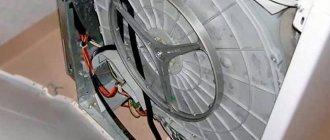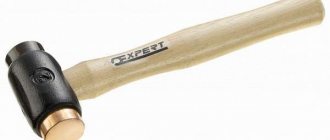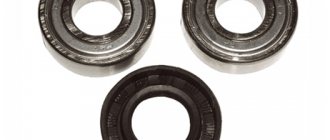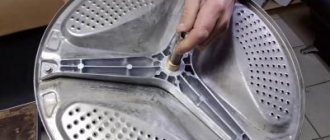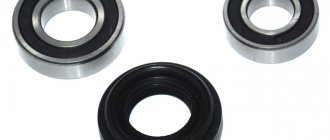The drive belt is an important part of the washer that rotates the drum. If it fails or falls off, the device stops performing its tasks. To restore functionality, you need to change the belt on a Samsung, LG washing machine or a model from another manufacturer.
Types of belts and how to determine the size
The belts used to drive the drum can be divided according to the following characteristics:
- manufacturer's company;
- length;
- number of tracks;
- profile type.
Both rigid and elastic belts are marked on the outside, the numerical designation of which indicates the length in millimeters for their working condition. If the marking contains the letters “EL” or “PE”, this means elasticity, where “PE” is stiffer than “EL”; accordingly, the sizes are indicated taking into account stretching and may not be suitable.
If you look at the inside of any ripple belt, you can see special grooves called rivulets. There are only two types of profile: profile “H” and “J”. The profile (rib pitch) of the engine pulley must match the belt profile. The “H” profile has a fine pitch, where the element height is 3 mm and the distance between the grooves (teeth) is 1.6 mm.
For a profile with large rib pitches “J” these dimensions are 4 mm. and 2.34 mm. As a rule, on a machine from any manufacturer you can install a belt in which the number of teeth is in the range from 3 to 7. In this case, profiles “H” and “J” are not interchangeable.
Expert advice
One of the most common factors for belt slippage is increased load; therefore, to increase the service life of the product, experts recommend keeping the weight of the laundry loaded into the drum under control and trying not to exceed the maximum load of the washing unit.
And one more thing - as a rule, during normal operation, the drive belt of a washing machine can withstand use for a period of 4-5 years. Therefore, the recommendation is that it is advisable to buy this important element in advance, so as not to carry out emergency work later.
How to change the belt on an Indesit washing machine, watch the video.
https://youtube.com/watch?v=yx335p7QbMg
What can cause belt problems?
A belt, like any other product, has its own expiration date. Over time, it may stretch or even burst. Sometimes, during intensive use, wear occurs much faster than we would like. This happens especially often in narrow models of washing machines, in which all elements and components are located as close as possible to the body. At first, as long as the shock absorbers and springs function properly, everything is fine, but as soon as they wear out a little, the belt begins to rub against the back wall when pressed. This, naturally, significantly speeds up the process of its “life activity”.
The opposite often happens: the belt on a washing machine has to be replaced because it is used too rarely. Long pauses in operation can cause drying out at the largest bend (in the area of the engine pulley). The “shrunken” area takes on a rigid shape and after the device is turned on, it quickly stretches and tears.
In some cases, replacing the belt on a washing machine is required because the user did not monitor the degree of wear of the bearings. Due to the resulting increased vibration of the pulley, the belt often stretches and falls off. Sometimes it even breaks.
The belt can also fly off due to a broken drum pulley, excessive volumes of loaded laundry, improper placement, or deformation of the tank.
Self-installation of the belt
If it is necessary to replace the belt on a washing machine, and not just reinstall the one that has fallen off, then it must be a completely similar product. The easiest way, when going to buy a new belt, is to take with you the remains of the old one and show them to the seller so that he can find exactly the same one for you. There are two main types of these products: wedge and poly-wedge. The former are installed on units with an asynchronous motor, the latter – on “washers” with a commutator motor.
V-belts break extremely rarely. They are tensioned, starting from the engine pulley and ending with the drum pulley. After the initial installation, the drum pulley is carefully rotated so that the belt sits completely
It is important that it is as tight as possible, otherwise problems with spinning may occur later.
Replacing the belt on a washing machine with a commutator motor is carried out in a similar way. It is advisable that it be located right in the middle of the drum pulley. The tension should not be too strong, so that the middle part can be wrapped 360 degrees. At the same time, the remaining sections should fit as tightly as possible.
It should be borne in mind that it is quite difficult to install poly V-belts on some models due to their elasticity. It may seem that the length is insufficient, but it is not. You just need to put in more effort, without forgetting naturally and about accuracy. Remember that overzealousness can seriously damage your hands. If the belt doesn’t “give” in any way, you don’t need to suffer, proving to others your masculine worth. The best thing to do in this case would be to seek help from professionals.
Urgent repair of large household appliances, dispatch of a technician on the day of your call and
Golden Hands service center - repair of household appliances in Moscow and the Moscow region, diagnostics and repair of washing machines, diagnostics and repair of refrigerators, diagnostics and repair of electric stoves, installation, diagnostics and repair of air conditioners. Visit of a repairman to your home in Moscow and Moscow Region, certificates, guarantee of the quality of repair work.
Read in the section washing machines - breakdowns and repairs
- Basic faults of washing machines
- Correct operation of washing machines
- Why doesn't the drum spin in the washing machine?
- The washing machine does not drain water, what should I do?
- The washing machine does not heat the water: possible causes of the malfunction
- Correct installation and connection of the washing machine
- Why does the washing machine knock out the machine?
- Why won't the washing machine start?
- Why doesn't the washing machine work?
- Why won't the washing machine open?
- Why does the washing machine jump?
- Why is the washing machine humming?
- Why is the washing machine leaking?
- Why doesn't the washing machine turn on?
- Why doesn't the washing machine spin?
- Washing machine repair technician
- Repair of washing machines in Moscow
- Washing machine repair at home
- Repair of washing machine circuit boards
How to replace the drum drive belt?
Let's look at cases when it may be necessary to replace or replace the washing machine drum drive belt yourself. But a loose or torn belt indicates certain signs of trouble that need to be identified and eliminated. After all, if it breaks, the belt can damage many electrical wires, sensors and other elements that are located in the back of the washing machine tank. We will also dwell on why the drum drive belt flies off or breaks.
Features of self-replacement and installation of the drive belt
V-belts. Installed on washing machines with asynchronous motors. In cross-section, such belts have the shape of a truncated triangle. The length of the belt is always indicated on the outside, according to which you can choose a new one if necessary. Made from tougher material. As a rule, they rarely tear.
The V-belt should be taut “like a string” and bend quite a bit in the middle. Otherwise, spinning problems and washing program failures may occur.
Installation of the fallen V-belt drive begins with the engine pulley, the remaining part is put on the drum pulley, after which carefully, forcefully rotating the drum pulley, we install the entire belt.
If the belt is stretched, you need to tighten it with the engine. To do this, you need to remove the belt, loosen the engine mounts, move it towards increasing the length of the belt, tighten the mount and install the belt. If the tension of the drive belt is not provided for by the design of the washing machine, then it must be replaced with a new one.
Poly V-belts. Installed on cars with commutator motors. In cross-section they have a jagged shape of several small wedges. They differ in length, which is indicated in millimeters, as well as in shape (“H” or “J”) and the number of wedges, the shape of which depends on the teeth on the engine pulley. For example, the designation on a poly V-belt “1287 H8” means that its length is 1287 mm, its wedges are shaped like “H” and their number is 8 pieces. The rest of the markings on the belt are not particularly important.
Installation of the poly V-belt must begin with the engine pulley, in the same place where it was previously located. Next, we put the remaining part of the belt on the drum pulley and, turning the pulley, install the belt completely. It is desirable that the position of the belt is in the middle of the drum pulley.
The tension of the poly V-belt must be such that the middle part can be wrapped around its axis 360 degrees, and further rotation must be very tight.
Separately, let’s say that on some models of washing machines (for example, narrow Siltal machines), poly V-belts are installed very tightly. This means that when putting the belt on the drum pulley, the belt may not appear to be the correct length. But this is not true, you just need to use more force than usual when putting on the belt and rotating the pulley, being careful not to injure your hands.
Narrow car models - more frequent belt wear
Accelerated belt wear is a “disease” of narrow washing machines. All components and elements of such models are located close to the body, and the belt is no exception. When a narrow car is still new, the springs and shock absorbers work properly. But subsequently they wear out a little, the amplitude of the tank during spin increases and as a result the belt begins to touch the back wall of the case.
This ultimately leads to damage and stretching of the belt. Then it needs to be replaced, since the stretched belt subsequently flies off and can damage wires and other elements.
The drum pulley cracked and the belt came off
A broken belt can also be caused by a cracked or broken drum pulley. The fact is that it is made of an inflexible but fragile alloy, which, if the laundry is overloaded, imbalanced or the belt is incorrectly tensioned, may not withstand and burst.
Belt fell off due to worn bearings
When the bearings of a washing machine are worn out, this, in addition to extraneous noise, also causes vibration of the drum pulley, which increases with each wash. If you use a washing machine for a long time with worn bearings, the vibration of the pulley becomes so strong that the belt can stretch and fly off during spinning, and in some cases break.
Overloading and imbalance of laundry lead to belt failure
Often, the reason why the washing machine belt comes off is a temporary imbalance of the laundry during the spin cycle. If the washing machine fails to evenly spread out the laundry before spinning, then during the spin cycle a sharp impact of the tank against the walls of the housing may occur. Strong shaking may cause the drive belt to fly off.
Therefore, it is recommended not to overload the washing machine and to properly place the laundry in the washing drum. Lay out each piece of laundry to avoid curling during washing.
Vertical models - flies off due to tank deformation
Such a malfunction often occurs on vertical models of Brand brand washing machines with the end of ECO (economy option) after approximately 8-10 years of operation. The fact is that over a long period of operation of the washing machine, its plastic tank is deformed, as a result of which the drum pulley and the electric motor pulley gradually shift relative to each other.
This causes the belt on the drum pulley to move towards the washing machine tub. Subsequently, the belt shifts so much that part of its plane begins to hang over the plane of the drum pulley, and it flies off during the spin cycle.
The problem can be temporarily solved by moving the engine towards the housing wall. This can extend the life of your washing machine by six months or a year.
To eliminate the malfunction, it is necessary to replace the tank and possibly the drum, which is not economically profitable. Therefore, in the end, such a machine has to be replaced.
Drying out and breaking of the belt as a result of infrequent use of the machine
Often the cause of belt breakage is its drying out at the point of greatest bend, where the belt goes around the electric motor pulley. For some reason, this happens mainly on vertical models and after they decide to use the machine after a long break in work.
That is, the bent section of the belt, when left in this state for a long time, dries out and takes on a certain rigid shape. After the rotation begins, this section, which has lost elasticity, begins to stretch and breaks off.
Source: https://www.azbuka-service.ru/remont_stiralnih_mashin/60/
Why doesn't it hold?
First of all, you need to look inside the car and make sure that the problem is in the belt. If this is the case, then here are the most popular reasons for the belt slipping:
- if the machine regularly operates under loads that it cannot handle according to its configuration, the belt will sooner or later fall off. If this happened for the first time, just pull the part back and enjoy the operation of the washing machine;
- If, when the drum is running quickly, the belt falls off not for the first time, it may have stretched. There is only one way out - replace it with a new one;
- Drive slippage can occur not only due to the drive itself, but also due to a loosely secured motor: the latter will periodically change its position and thereby weaken the belt. To fix the problem, secure the motor more securely;
- loose pulley fastening is also the reason for the belt to fly off. All that is required is to re-tighten the pulley;
- the pulley or shaft may be deformed (often the belt itself, flying off, bends them). In this case, you need to buy a new part;
- the shaft is connected to the body of the washing machine using a cross. Consequently, if the crosspiece is damaged, the belt will fall off. The solution is to buy a new cross;
- worn bearings can cause the drum to move skewed, which will first lead to a loosening of the belt and then to its disconnection;
Types of drive belts
Before deciding how to tighten the belt in a washing machine, let’s find out what they are.
Wedge. A type of belt used for asynchronous motors. Its shape resembles a trapezoid or a truncated triangle, the parameters are indicated on the outside. Due to the rigidity of the material, the product is quite durable and quite elastic.
When installing, it is important that the middle part is slightly free. Incorrect installation can lead to program failures
Poly-wedge. Installed on commutator electric motors. Consists of a series of wedges that form a jagged shape. It is stretched a little weaker than the wedge one. Although there are washing machines where it is set very tightly. Then during installation you need to apply additional force.
Replacing the belt in a Samsung washing machine. Step by step guide.
Samsung washing machines do not have many shortcomings, and if they are eliminated in time, the washing machine will serve for a long time and with high quality. These disadvantages include a silicone belt and a weak drain pump. We'll talk about the drain pump another time. In this article I want to share with you my experience in repairs, and consider such a pressing issue as replacing the washing machine belt. The standard configuration of a Samsung washing machine includes a three-strand silicone belt with a nylon backing, and what’s most interesting is that it lasts almost exactly three years from the date of purchase and fails at the end of the warranty period. If you are the happy owner of a Samsung washing machine, then you will understand me.
How can you tell when it's time to change the belt in your washing machine?
The first reason: your machine has stopped turning the drum, although you can hear that the engine is running. The problem is most likely that the belt has broken or fallen off.
The second reason is that when the load is light, the drum jerks in place and the engine cannot turn it. Reason: the belt became thin, lost its rigidity and stretched.
The third reason is that the drum rotates when the load is light and does not rotate when the load is fully loaded. The reason is also in the belt.
The fourth reason is that when the drum rotates, extraneous sounds arise, as if something is rustling or touching inside. The reason is that the belt has delaminated, and its fragments hit the walls of the case and parts of the washing machine. This situation is the most unpleasant and can lead to serious consequences. Fragments of the belt can snag the wires and break them, as well as wrap around the engine and cause its failure.
These are the main reasons why belt replacement is vital!
How to change the belt in a washing machine?
This is not difficult to do if you have the slightest technical skills.
The first thing you need is to purchase a quality belt. I recommend purchasing a Megaden 1270 J5 belt. This belt is made of high-quality rubber with nylon inserts, which increases its strength and rigidity. Its size is 1270 mm and has 5 streams in width. Then, using a Phillips screwdriver, remove the top cover by unscrewing two screws. We move the machine away from the wall about forty centimeters and tilt it back in order to gain access to the bottom of the washing machine. Next, remove the plastic plug covering the bottom of the machine (if you did not do this during installation)
Also pay attention to the amount of chips from the belt on this substrate; if it is present, then this is also a signal to replace the belt. There is no need to put the plug back, for better internal ventilation
The next step is to remove the old belt (1270 J3). If it becomes frayed and wound around the engine, then it is necessary to remove all fragments of the belt. If the wires are broken, you need to splice them according to color and be very careful. If you do this incorrectly, the electronic unit will burn out.
Next, due to the fact that Samsung washing machines do not have a back wall, we do the following. We take a strong, not thick thread (you can use fragments of an old belt) 70 cm long and tie it to the new belt. Then we pass the belt through the top and with one hand we put the belt on the engine, and with the other we pull the thread up so that the belt does not jump off the engine pulley. We put the machine in the normal position, hook the edge of the belt onto the drum pulley and rotate clockwise, put the belt on the pulley. Cut the thread.
It is important to check the position of the drive belt on the drum pulley. The ideal option is when the belt is in the middle, but the position of the belt at the edge of the pulley is also allowed, the main thing is that it does not hang down
If you did everything correctly, then when the drum rotates, there should be no extraneous sounds.
If you are unable to replace the belt yourself, it is better to call a technician. The cost of replacing a belt in St. Petersburg is 1000 rubles plus the cost of the belt.
Replacing the belt on a Vestel washing machine is the same as on a Samsung machine.
How to tension a new belt
To tighten the new belt, you need to tie a strong cord or secure a wire to the pass. Next, the part needs to be lowered through the top and secured behind the engine pulley. Gaining access to this part of the machine is easy: just tilt it so that the tank moves. By working with an assistant, you can simplify this task, because... another person will be able to hold the fastener and evaluate the correct tension.
The next step is to pull up and put the part on the drum pulley. The pass must be placed in the central part of the lane and firmly recorded.
Finally, all that remains is to remove the auxiliary cord and start the washing machine to check its functionality. To protect the device from damage or the drive belt falling off, it is necessary to place it on a flat surface and avoid overloading the drum. Replacing the belt in a Samsung washing machine yourself is not a difficult task. The main thing is to follow the step-by-step guide and adhere to the installation rules.
Replacing the belt on a Samsung washing machine
You can handle some washing machine breakdowns yourself. Even if you have no experience in repairing complex household appliances, replacing the belt can be done within a short time. This operation does not require expensive equipment, and all you need is a screwdriver and an adjustable wrench. How to change the belt on a Samsung washing machine will be discussed in detail in this article.
Fault diagnosis
Replacing the belt of a Samsung washing machine will require removing the back panel, disconnecting the device from electricity and the water supply network, so the first thing you need to do is make sure that the drive belt is the cause of the non-operation of the household appliance. This malfunction may have the following symptoms:
- The motor runs, but the drum does not rotate.
- The drum rotates jerkily, and the smell of burnt rubber is felt in the air.
- Extraneous sounds are heard when the drum rotates.
This important part of the washing machine does not always fail so much that the household appliance stops working. In the early stages of wear of this part, problems can only occur when the washing machine is fully loaded. If in such a situation the drum begins to jam, then you should not wait for the situation when the engine jams or a loose belt breaks the internal wiring wires. If you suspect such a problem, you should immediately begin troubleshooting the problem.
Belt replacement
Before you begin repairing a household appliance, it should be disconnected from the electrical network and communications. If it is not possible to remove the back panel of the washing machine without changing its location, then the device extends in such a way that during operation it is as convenient as possible to replace the belt. Then you should prepare a slotted and Phillips screwdriver. Replacing the drive belt is carried out in the following sequence:
- Unscrew the screws holding the back cover and carefully remove the panel.
- Using a slotted screwdriver, you need to pry the part, bend it to the side and remove it from the pulley, turning it slightly clockwise.
- A new belt is installed in place of the worn part. To do this, first place it under the lower pulley, and then, placing the belt on one side on the grooves of the pulley, turn it half a turn.
- Rotate the upper pulley 1 - 2 turns to check the belt drive.
- Assemble the washing machine.
After all communications are connected, the washing machine should be started in test mode to ensure its functionality.
Top belt installation
Some models of washing machines do not have the ability to remove the back cover, so many craftsmen are interested in the question of how to tighten the belt in a Samsung washing machine. In this case, the actual process of replacing the part becomes much more complicated. To carry out such an operation, you will need to open access to the internal parts of the household appliance from below or from above. The second option is more preferable, because to remove the top panel it is enough to unscrew two screws. Then the cover is moved back and up a little, after which access to the belt drive will be opened. Before proceeding with this operation, you must also disconnect the device from the electrical and water supply networks.
Troubleshooting
To organize the normal operation of the Indesit washing machine, it is necessary to install the belt on the pulley. This kind of work can only be done when communications are turned off. You should also drain the remaining water from the device through the emergency drain.
How to get to the belt in an Indesit washing machine with vertical and horizontal loading?
The ability to gain access to the drive belt depends on the model of the Indesit machine.
In front-loading devices, it is organized from the rear wall. To replace a part, you need to pull out the washing machine and remove the service hatch cover, which is located at the back. The cover is secured with screws.
In Indesit top-loading machines, the belt can be accessed by removing the side panel. To do this, you need to unscrew all the screws holding it.
How to change, tighten?
After access to the pulley and belt has been gained, the entire assembly should be inspected, paying attention to the secure fastening of all parts involved in rotating the drum. If the cause of the part jumping off has been established, it must be eliminated first.
Installation process:
- Inspect the old belt, checking its condition and integrity. If it is torn or has become dilapidated, it should not be mounted on the pulley. This part cannot be repaired - only replaced.
- Inspect the condition of the parts and components associated with the belt. If a defect is identified, it must be eliminated before installing a new belt.
- Throw the new part onto the electric motor pulley, which is located below.
- How to put a belt on a large pulley that is located on the drum - it is more convenient to do this by spinning the wheel. To work, you need to use both hands - one to pull the part, and the other to spin the wheel.
- Checking the installation.
When putting on the belt, it is important to ensure that the part fits neatly into the groove provided for it. The video will tell you about replacing the belt in an Indesit horizontal-loading washing machine:
The video will tell you about replacing the belt in an Indesit horizontal-loading washing machine:
Video about replacing the belt in a top-loading Indesit washing machine:
Reassembly
After installing the belt, it is necessary to restore the position of the removed housing panel. And only after this can the communications connection be restored. A test run without loading laundry completes the replacement.
What is the purpose of replacing rubber?
Sometimes a Samsung washing machine refuses to work due to minor breakdowns, and this does not mean that you should contact a service center for help every time. To ensure that the laundry washing machine does not have interruptions and fully performs all the specified functions, it is recommended that from time to time you replace or clean the rubber gasket designed to ensure tightness during operation. Such actions are performed in certain cases:
- the rubber band is removed in order to clean the space underneath it, check the drainage area for dirt accumulation,
- The rubber band is replaced after a certain operational period, when it has lost all its properties and does not fulfill the task of sealing the unit.
It is possible to determine whether the element needs to be replaced or cleaned through inspection - if integrity is damaged, there is visible contamination or an unpleasant odor is detected, appropriate measures are immediately taken. In addition, a clear sign of failure will be water flowing out from under the hatch during the washing process.
Features of repairing washing machines of famous brands
With washing machines of a high price category, breakdowns typical of these household units also occur. As a rule, machines from well-known brands such as Samsung, Bosch, Lg are equipped with an electronic control system.
So, for example, error E8 in a Samsung car means that the water temperature does not correspond to the selected program, which means that interruptions in the operation of the heating element have begun. Such automatic diagnostics help determine the type of malfunction and decide whether it is possible to repair a Samsung washing machine yourself.
Knowing the typical malfunctions and the reasons for their occurrence, it is easy to repair the washing machine yourself. Of course, it is better to entrust the repair of electronics or complex components to a professional, but replacing individual parts or cleaning filters is within the power of anyone.
Replacing the belt in a Samsung washing machine
The following factors may be the reason for replacing the washing machine belt:
- An incomprehensible noise appears during operation;
- Upon visual inspection, the belt seems to be in place, but near the places where the belt passes, as well as on all underlying planes, a dust resembling dirt is found, and to the touch it resembles an eraser (it also rolls into pellets);
- The service life of the washing machine is 6-7 years (the service life of the drive belt).
The reasons listed above should make you think about a preventative technical inspection, and maybe repair, which involves replacing the drive belt.
This article will describe the process of replacing the belt on a Samsung washing machine. On all models of this brand, the back panel is not removable, which greatly complicates repairs.
So, what is needed to replace the belt:
- Purchase a similar belt (you can use the markings on the belt itself, or you can provide the old version as a sample);
- Electrical tape (small piece about 10-15 cm);
- Wire (diameter 0.5-0.8 mm, length about 0.5 m);
- Wire cutters;
- Flashlight.
- crosshead screwdriver
Below is a diagram showing how best to install the belt.
The diagram shows:
- Engine drive gear;
- Washing machine drum rotation pulley;
- Belt;
- Belt fixation.
Replace the belt in the following sequence:
- First, inspect the machine's drive gear and drum drive pulley. You should note that the gear has grooves for the counter grooves on the belt and, as a rule, during long-term operation a mark is formed from the previously installed belt. It is recommended to install the belt for this model of machine from the top. Therefore, keep in mind that when placing the belt on the drive gear, you need to try to get to the place where the previous belt was. If you have moved the belt too close to the end of the gear, then you will not immediately understand how it will fit on the drum pulley and it may turn out that part of the belt on the pulley will hang down or be on the edge. Then you will have to dismantle and do everything again, taking into account the initial positioning on the gear.
- After you have placed the belt on the drive gear, you need to place the belt on the pulley on the side to which the drive gear is offset. Look at the diagram and you will understand what we are talking about. Having brought the belt to the top point, you need to select a position for the pulley where there is support from turning the fastener. The fastener will not be able to secure the belt from turning; it will tend to move in the direction opposite to rotation and will be stopped by the stop.
- To secure the belt, first use electrical tape to prevent wire damage to the belt during installation. Then securely fix the wire over the electrical tape. We make 5-10 turns and secure the edges by twisting them together. After this, rotate the pulley in the direction of installing the belt.
- After the final installation of the belt on the pulley, there will be a characteristic click of the belt and further rotation will not be possible, since the belt will move onto the gear, but it will be stopped by our clamp. Turn it in the opposite direction and remove the lock. That's it - belt installation is complete. The process itself takes about 20 minutes if you put the belt on the gear correctly. You can check this by turning the pulley a few turns. The belt will take its position on the pulley and align with its position on the gear. And then see how you like it.
In case of dismantling, you need to move the belt by hand at the transition point from the gear to the pulley, in the direction of rotation in front of the pulley, and rotate the pulley. The belt should come off on its own.
In addition, 2 people are desirable here; as an option, you can put the machine on its side, always with the powder dispenser down, otherwise residual water may get on the board. One person will hold the belt on the pulley (not the gear) of the engine, and the second person will tension the belt from above. Then the machine can be lifted and, maintaining tension, put on the drum pulley.
Causes of belt failures
Belt wear
In narrow devices, all elements are located very close to each other and to the body. Therefore, at the moment of wear, such parts are free and rub against each other, causing severe wear.
Cracked drum pulley
There are several reasons: the pulley is cracked, the automatic machine was overloaded, the element is not tensioned correctly. A broken pulley cannot hold the belt, so it must be replaced.
The cause of the failure is wear of the bearings
Severe wear can lead to high vibrations of the spin unit and the device drive. When they reach their peak, the strap stretches, slips, or breaks. After which repairs are required.
Incorrect loading and operation of the washing machine
The belt can fly off if the drum is not loaded correctly and excessive vibration is caused.
This element can dry out and become very thin if the equipment sits idle for a long time. Very often, in side-loading machines, plastic parts exhibit fatigue deformation, which leads to a violation of the arrangement of the elements. After which the strap may fly off along with the pulley shifting. In such situations, it is better to buy a new device than to adjust the equipment.
Repair algorithm
If the belt came off for the first time, then it is enough to return it to its place. Despite its apparent simplicity, this procedure often causes difficulties. The fact is that stretching the rubber will require skill, strength and remarkable patience from the master. But even a “newbie” can cope, the main thing is to show persistence and strictly follow the instructions.
When the belt falls off regularly, it is necessary to carry out a comprehensive diagnosis of the washing machine - perhaps there is a more serious problem. The elastic band is returned to its place according to the following algorithm.
- We check that the washing machine is disconnected from the sewerage and water supply. We also disconnect the inlet and drain hoses from the body.
- We provide free access to the machine by moving it away from the wall or headset, and turn the unit with the back wall towards you.
- Unscrew the screws holding the back panel and remove it. On some Samsung machines, the top cover prevents removal of the back wall. In this case, the “top” is removed first.
- We find the drive belt. It should be located just behind the rear panel between the drum “wheel” and the motor pulley. If it is not in place, then it has flown off and is located somewhere at the bottom of the case.
- We take out the belt and assess its condition. First, we find the markings applied to the rubber, where the first four digits indicate the original diameter in millimeters. Next, measure the circumference and compare the resulting value with the factory length. If the calculated difference is equal to or greater than 20 mm, then throw away the elastic band - it has stretched too much due to long-term use and is no longer suitable for use.
- We pull the belt onto the engine pulley, and then, carefully rotating the drum “wheel” counterclockwise, we try to put the elastic band in place. For quick results, it is better to involve an assistant, since it is easier to handle the tension with two hands than with one. But be prepared to spend a lot of time: on some Samsung models the rubber is too tight, and the manufacturer does not provide for adjustment.
- We make sure that the belt is tightly seated in all existing grooves by turning the pulley several times. If the “wheel” rotates very tightly, then the rubber is tensioned correctly.
Having visually checked the quality of work, we proceed to reassembly. We return the back wall to its place and fasten it with the removed bolts. Then we move the washing machine to the wall or into the unit and connect it to communications. Be sure to run a test wash and check that the machine is functioning properly.
Debugg
In order to check whether the belt on the washing machine has come off or there is some other reason for the malfunction, the device is disconnected from the power supply. Then the back cover is removed; to do this, the bolts holding it are unscrewed. A loose or damaged belt is removed and inspected. It can then be worn again if it is in good condition or replaced with a new one if it is completely worn out.
If you need to put a belt on a washing machine, put it on the shaft and pull it onto a uniformly rotating pulley
During this process, it is important to adjust the edges of the belt so that it fits evenly into the sinuses. After completing this operation, the cover is installed in its place and a test run of the machine is performed.
Why does the belt drive fall off?
Thanks to the belt drive, the drum pulley rotates. Like any mechanical transmission, it can be damaged. If the strap comes off once, no problem - below we will tell you how to install the strap yourself, without calling a technician. But it happens that the drive belt has to be returned to its place over and over again. Causes of the problem:
- Wear. During operation, the strap stretches, which is why it comes off the wheel. Having weakened, it also makes a characteristic noise - whistling. The element may be damaged and even torn. To inspect and determine the degree of wear, open the back panel.
- Pulley fastening is broken. Check the fastening and tighten if necessary.
- Poor motor mounting. Check and, if necessary, strengthen the fasteners.
- Deformation of the pulley and shaft. These elements can bend due to an unsuccessful belt. A defect is also possible - then the SMA is returned in accordance with the warranty obligations. Deformed parts require replacement.
- Damage to the crosspiece. The tank and the shaft are connected by a cross - if it bursts or weakens, the balance is upset. Fastenings need to be changed or tightened.
- Incorrect installation of the belt drive. When installing on your own, mistakes are often made. It is better to call a specialist to fix the problem.
- Spare parts do not fit. If a pulley or belt was replaced with new ones purchased in a store, they may not fit.
- Bearings are worn out. Because of this, the drum skews when rotating, and a knocking sound is also heard during the spin cycle.
Signs of breakdown
The drive belt for a washing machine with an asynchronous/commutator motor is an irreplaceable part. If he leaves his place, the SMA stops. There will be no washing. But how can you guess what happened? The user cannot see what is happening in the machine body. Modern SMA models are equipped with a self-diagnosis system - it notifies the owner of the problem. A digital error code appears on the display, all that remains is to decipher it - read the meaning in the instructions. It doesn’t matter if the instructions are lost; information with error codes for a specific model can always be found on the Internet.
It also happens that the machine is faulty, but there is no error code. The problem can be identified by indirect signs:
- When the program starts, the motor runs and the drum stops;
- The electric motor emits a uniform hum and then, at regular intervals, subsides;
- After starting the program, the engine starts working, and the electronics “freeze”;
- The drum can be easily rotated by hand, and rotation does not cause noise.
Belt replacement
Before you begin repairing a household appliance, it should be disconnected from the electrical network and communications. If it is not possible to remove the back panel of the washing machine without changing its location, then the device extends in such a way that during operation it is as convenient as possible to replace the belt. Then you should prepare a slotted and Phillips screwdriver. Replacing the drive belt is carried out in the following sequence:
- Unscrew the screws holding the back cover and carefully remove the panel.
- Using a slotted screwdriver, you need to pry the part, bend it to the side and remove it from the pulley, turning it slightly clockwise.
- A new belt is installed in place of the worn part. To do this, first place it under the lower pulley, and then, placing the belt on one side on the grooves of the pulley, turn it half a turn.
- Rotate the upper pulley 1 - 2 turns to check the belt drive.
- Assemble the washing machine.
After all communications are connected, the washing machine should be started in test mode to ensure its functionality.
Our advantages
- Free repair consultation
. There is a Question and Answer section on the website specifically for your questions. Describe your problem and receive a detailed comment from a specialist. You can also leave a request for repairs: the specialist will contact you by phone and advise on your issue. - Free visit and diagnostics
. If you agree to carry out the work by RemBytTech, a specialist visit and diagnostics of the washing machine are carried out free of charge. - Repair right at your home within 24 hours after your request
. Thanks to the presence of craftsmen in all districts of Moscow and most cities in the Moscow region, our specialists serve orders in the shortest possible time - within 24 hours after the request. All work is carried out at the customer’s home; there is no need to take the equipment to the workshop. - We work from 8 to 22 hours
. Our technicians visit clients from early morning until late evening, seven days a week and seven days a week. You can easily choose a time for the specialist’s arrival that is convenient for you. - Warranty up to 9 months
. The work on replacing or installing the drive belt of the machine is covered by a 9-month warranty (for work and for spare parts, if they were purchased from our specialist).
We are looking for a heater in the housing
In washing machines from Beko, the tubular electric heater is located in a standard place for machines - under the tank. Getting to the heating element is not difficult: just disconnect the equipment from the network and water supply, unfold the case, remove the back panel, remove the drive belt and take a closer look. Immediately below the bottom of the drum there will be the desired element - a round metal “die” with many connected wires.
It is impossible to confuse the heating element with a motor or another element of the washing machine - it is always under the tank and surrounded by wiring. This is the first thing that catches your eye after disassembling the machine.
While it is not difficult to find and replace the heater, problems often arise in determining the cause of the breakdown. The heating element fails due to many problems, and before work it is recommended to carry out a comprehensive diagnostics of the device. As a rule, the following malfunctions lead to “thermal failures”:
- sudden power surges in the network;
- incorrect operation of the heating element temperature sensor;
- overheating of the device due to a thick layer of scale (if the water in the water supply is dirty or too hard);
- water getting on the contacts;
- human inattention or error;
- manufacturing defects.
In most cases, replacing a faulty heating element will eliminate the problem. It’s worse if the control board is “to blame.” A module that is not working correctly, for example, due to damaged “tracks” or loose contacts, must be repaired separately. However, it is strongly not recommended to repair the electronic unit yourself - it is safer to contact a service center.
Let's determine what's broken in the car?
Many modern automatic washing machines are capable of diagnosing various types of faults themselves. And convey information to the user with special signals or codes appearing on the control panel. Even if such diagnostics are not provided for in your washing machine, it is better if you figure out on your own which symptoms correspond to which breakdowns.
This kind of information is not difficult to find. As they say: forewarned is forearmed. For example, if the washing machine does not drain water, and they tell you that you need to change the motor or the bearings in the drum, they shamelessly lie to you and want to scam you out of money.
Possible causes of malfunction
- Belt wear. The most common reason why it can fly off. If the belt is stretched, then during operation it flies off the drum or simply slips, making whistling sounds. Sometimes the belt breaks at the point of wear.
- There is a problem with the pulley fastening. The pulley can come loose, causing the belt to fly off. Check the fastening for tightness and tighten if necessary.
- The engine mount is loose. The engine can become loose over time, causing the belt tension to decrease. Check how well the engine is secured.
- Deformation of the pulley or shaft. When a belt comes off, it can damage the pulley or the shaft itself. In this case, replacing the belt will not work; you will have to replace all the damaged parts. It happens that a pulley or shaft is initially irregular in shape due to a manufacturing defect. If such a malfunction is discovered during the first operation, it is better to immediately return the machine under warranty and demand a replacement.
- Damage to the crosspiece. The crosspiece connects the shaft to the tank; it can weaken or completely burst, which will create an imbalance and lead to the belt breaking. The bolts should be tightened or the crosspiece should be completely replaced.
- Incorrect installation of belt or pulley. If you have already tried to repair these parts, you may have made a mistake during assembly. Contact a specialist for help.
- The pulley or belt does not fit your machine. When doing your own repairs, you may have purchased the wrong part.
- Bearings are worn out. This causes the drum to rotate unevenly, which can cause the belt to fly off. This malfunction may be indicated by the machine knocking in the spin mode.
To change the washing machine belt yourself, you must follow these steps:
- Turn off the water and unplug the washing machine from the outlet.
- Unscrew the fastening screws on the back wall of the machine and remove it.
- Remove the old belt: to do this, you need to pull it towards yourself while simultaneously rotating the pulley by hand.
- Place the new belt on the motor shaft.
- Carefully pull the belt onto the pulley, also rotating it by hand.
- Check that the belt is level and adjust it if necessary.
- Replace the back cover.
- Run a test wash to make sure the machine is working properly.
Pay attention to whether the belt has damaged wires, sensors and other elements located nearby. It is advisable to diagnose and eliminate these faults along with replacing the belt. How can the user understand that there is a problem with the drive belt? Certain signs indicate faulty parts: error codes, extraneous sounds
How can the user understand that there is a problem with the drive belt? Certain signs indicate faulty parts: error codes, extraneous sounds.
Find out how you can diagnose a breakdown yourself, what signs you need to look out for, and how to replace the drive belt in your washing machine. How to determine that there is a problem with the drive element in the SMA:. How to determine that there is a problem with the drive element in the SMA:
How to determine that there is a problem with the drive element in the SMA:
- The self-diagnosis system of the washing machine showed an error code on the display.
- When washing, the drum does not rotate, but it can be turned by hand.
- During operation, the drum rotates very slowly, and extraneous scraping sounds are heard.
You can accurately determine the cause of the problem by removing the wall of the washer and inspecting all the parts.
Why does the belt come off? Here are the most common causes of the problem:
Problems with the drum pulley. Improper loading of laundry, overload and imbalance can lead to malfunction and breakage of the pulley. As a result, the belt jumps off and falls off, which leads to a stop in the operation of the SM.
- Wear. Each belt has its own service life. But few products work before the end of this period. The probable cause of wear is the design of the washing machines. Narrow machines have parts that are tightly packed together, which leads to rapid wear.
- Incorrectly folded laundry. If the drum is overloaded, an imbalance occurs - all the laundry is shifted to one side. When spinning at high speeds, the drum may suddenly hit the tank, causing the drive element to jump off.
- Problems with bearings, which are needed for uniform rotation of the drum. If the bearings are not replaced in time, this leads to severe vibration of the pulley. Consequently, the belt can not only fly off, but also break.
Too infrequent use of the SMA causes the belt to break. How does this happen? With infrequent use, areas of the drive element shrink. The next time they are started, they fray, which leads to stretching and breakage.
Recurrence of malfunction
If the rubber band breaks off the pulley periodically, this may indicate certain problems in the system. When the belt falls off more than 2 times within 6 months, you need to be wary and diagnose the “home assistant”. The main reasons for repeated flying off of an element from the functional wheel of the drum and the motor can be considered:
- drive belt wear. Very often it falls off precisely because of its natural stretching. If there are traces of wear on its surface, the wedges are selectively ground off, the length has noticeably increased in comparison with the factory one, it means that the elastic band has exhausted its service life and needs to be replaced;
- pulley play. In such a situation, the belt is not securely fixed to the wheel and will periodically fly off when the drum rotates. Dealing with the problem is quite simple - just tighten the mounting bolt or replace the pulley;
- weak fixation of the electric motor. The motor of the Samsung washing machine is securely fastened, but due to the constant vibrations of the machine during operation, the bolts can become loose and the engine becomes loose. This leads to disruption of the belt drive. To fix the damage, fix the engine in place by tightly tightening all its fasteners;
- incorrect shape of the shaft or functional wheel. After an unsuccessful repair, during which the “unfortunate masters” bent the pulley, problems with the drive belt may begin. There is a way out of the situation - you can carefully straighten the uneven surface, but the best option would be to completely replace the pulley;
- cross defect. In some cases, users of a Samsung washing machine may experience damage to the shaft and cross. This can happen either due to the fault of the manufacturer (if there is a manufacturing defect) or due to vibrations generated by the washing machine during operation. The crosspiece must be changed, otherwise a defective part can lead to imbalance of the drum and provoke a more serious problem with the MCA;
- broken bearings. Very rarely, users bring their automatic machine to this state, but it still happens that a defect in the bearings leads to “distortion” in the system and, as a result, the belt comes off. The problem can only be fixed by replacing the drum bearings and oil seal.
Errors made during previous repairs of the element can also lead to periodic decline.
We are talking about installing the drive belt not completely - if it was not secured in the grooves, sooner or later another fly-off will occur. It also happens that the elastic band is not replaced with a similar one, but somewhat different from the original. Then we can also expect it to fail. To prevent the belt from falling off, it is necessary to replace the element with a new one that is suitable for the specific model of the Samsung washing machine.
So, having figured out the cause and eliminated it correctly, you can forget about problems with the belt drive for a long time and continue to use the washing machine.
Interesting:
- How to put a belt on a washing machine
- How to tighten the belt on a Bosch washing machine?
- Should I buy a direct drive washing machine?
- Types of washing machine drives
- Changing the belt on an Ariston washing machine
- Rating of Samsung washing machines
Reader comments
- Share your opinion - leave a comment
Replacing the belt on a Samsung washing machine
You can handle some washing machine breakdowns yourself. Even if you have no experience in repairing complex household appliances, replacing the belt can be done within a short time. This operation does not require expensive equipment, and all you need is a screwdriver and an adjustable wrench. How to change the belt on a Samsung washing machine will be discussed in detail in this article.
Fault diagnosis
Replacing the belt of a Samsung washing machine will require removing the back panel, disconnecting the device from electricity and the water supply network, so the first thing you need to do is make sure that the drive belt is the cause of the non-operation of the household appliance. This malfunction may have the following symptoms:
- The motor runs, but the drum does not rotate.
- The drum rotates jerkily, and the smell of burnt rubber is felt in the air.
- Extraneous sounds are heard when the drum rotates.
This important part of the washing machine does not always fail so much that the household appliance stops working. In the early stages of wear of this part, problems can only occur when the washing machine is fully loaded. If in such a situation the drum begins to jam, then you should not wait for the situation when the engine jams or a loose belt breaks the internal wiring wires. If you suspect such a problem, you should immediately begin troubleshooting the problem.
Belt replacement
Before you begin repairing a household appliance, it should be disconnected from the electrical network and communications. If it is not possible to remove the back panel of the washing machine without changing its location, then the device extends in such a way that during operation it is as convenient as possible to replace the belt. Then you should prepare a slotted and Phillips screwdriver. Replacing the drive belt is carried out in the following sequence:
- Unscrew the screws holding the back cover and carefully remove the panel.
- Using a slotted screwdriver, you need to pry the part, bend it to the side and remove it from the pulley, turning it slightly clockwise.
- A new belt is installed in place of the worn part. To do this, first place it under the lower pulley, and then, placing the belt on one side on the grooves of the pulley, turn it half a turn.
- Rotate the upper pulley 1 - 2 turns to check the belt drive.
- Assemble the washing machine.
After all communications are connected, the washing machine should be started in test mode to ensure its functionality.
Top belt installation
Some models of washing machines do not have the ability to remove the back cover, so many craftsmen are interested in the question of how to tighten the belt in a Samsung washing machine. In this case, the actual process of replacing the part becomes much more complicated. To carry out such an operation, you will need to open access to the internal parts of the household appliance from below or from above. The second option is more preferable, because to remove the top panel it is enough to unscrew two screws. Then the cover is moved back and up a little, after which access to the belt drive will be opened. Before proceeding with this operation, you must also disconnect the device from the electrical and water supply networks.
How to understand that the problem is in the belt?
It is impossible to immediately say that the drive belt has fallen off: the elastic band is “hidden” behind the rear panel and it is difficult to confirm the guess without a screwdriver. But based on some telling signs, you can understand that the problem with the washing machine stopping lies in problems with the drive. The very first and irrefutable evidence will be the signal from the self-diagnosis system.
Washing machines can automatically detect breakdowns and report them to the user in encrypted form thanks to the built-in self-diagnosis system. If the washing machine is equipped with a display, the corresponding error code will be displayed on it. You just need to find a table with a decoding suitable for a specific Samsung model, and look for the sequence that pops up among the combinations. As a rule, such lists are publicly available on the Internet. You can also find out the answers in the user manual.
But the self-diagnosis system does not always “detect” a fallen belt. Sometimes a breakdown goes unnoticed, and you need to guess about the problem through indirect “symptoms”. So, you can suspect problems with the drive in the following situations:
- The washing program is turned on, the water has filled up, the motor is running, but the drum does not rotate;
- The engine of the car either hums rhythmically, then stops and “goes silent.” State changes occur at regular intervals;
- the cycle begins, the engine runs without interruption, but the electronics “freeze” and the machine does not respond to user commands;
- The washing drum rotates manually with ease, but the motor does not make noise.
You cannot operate a washing machine with a broken drive belt - the engine runs idle and overheats.
If you notice at least one of the signs listed, then you should stop the cycle and check the drive belt. We prepare a screwdriver, disconnect the washing machine from communications and begin a mini-diagnosis. To do everything correctly, follow the instructions described below.

